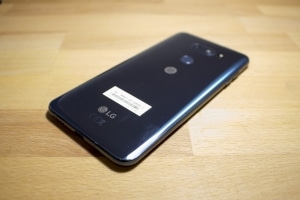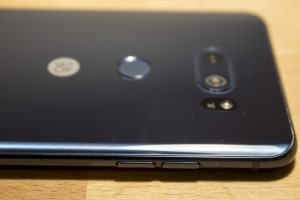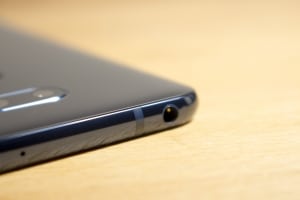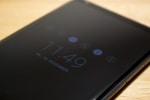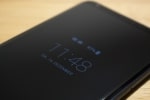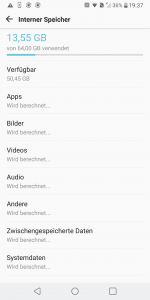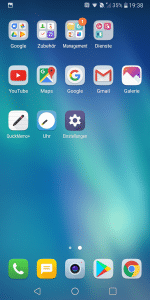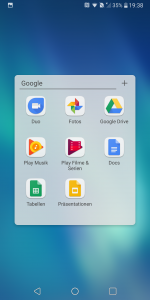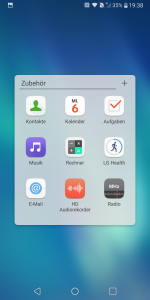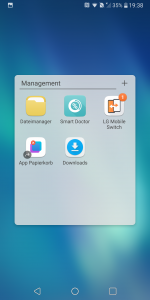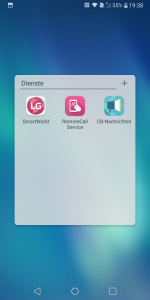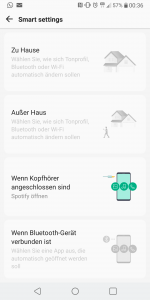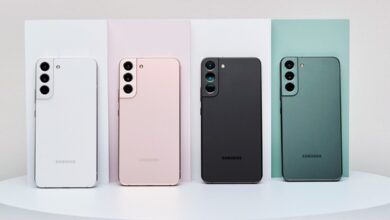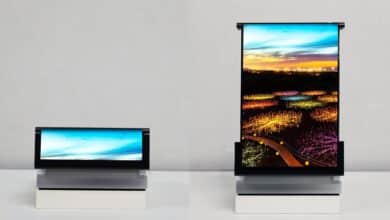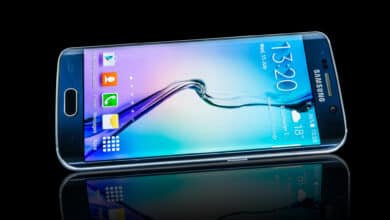
With the LG V30, which was recently launched on the market, LG is expanding its successful V series with another high-end smartphone. The smartphone, which costs just under 890 euros, is being advertised with many new features. Thus, the second display, which has characterized the V series so far, is dispensed with. The “Cinema Camera” and the Quad-DAC of the new V-Smartphone will be highlighted. The following practical test will show to what extent the full-bodied promises can be kept.
Design and Workmanship
Surprisingly light with a weight of 158 grams, the smartphone lies well in the hand. Measuring 151.7 x 75.4 x 7.3 millimetres, it is the ideal size for a smartphone. It fits in one hand, offers enough free space and can easily be stored in your trouser pocket. The huge display that clearly dominates the design of the front continues to be conspicuous. The corners of the touch screen are rounded as well as the corners of the case. At first glance, a comparison with the top model Galaxy S8 from Samsung is obvious, as the two phones are quite similar in size and design. The display represents a distinctive differentiation point here: While the S8 is bent around the edge of the smartphone, making it “invisible”, this is not the case with the V30. The edge of the phone is quite thin, but is not taken up by the display. This makes the V30 look less extravagant, but it could have advantages in handling, which is mainly due to the fact that most users are used to such a display.
The front and back are not as extremely rounded as their Samsung counterparts. Optically the LG V30 knows how to convince completely. It looks enormously high-quality, feels good and looks very noble despite its rather functional design. At first glance, there are also no weak points with regard to workmanship. The entire smartphone looks very stable and well processed. All corners and edges are pleasantly rounded. A closer look, however, reveals a tiny gap between metal and glass on the front. This is certainly not a workmanship error, but a deliberate detail that serves to accommodate individual components. Nevertheless, this solution is rather suboptimal, since this gap is suitable as a collection point for dust and other undesirable substances. However, dust cannot penetrate inside the smartphone as it is dustproof and waterproof, which is certified to IP68.
The power button with integrated fingerprint sensor can be found on the back of the V30. It looks very well placed there, as it can be reached and operated without any problem. The difficulty of accommodating this button was ideally solved from both a practical and ergonomic point of view. The only discomfort is a slightly plastic-like noise when pressing the button. However, this point of criticism should not deter anyone from buying, since it is also given for comparable products of the competition.
Display
As already mentioned, the rather large display dominates the entire front of the LG V30. It is high-quality processed, has rounded corners and has been very well designed from a design point of view. The display is a FullVision screen with a screen diagonal of 6 inches in 18:9 format.
LG continues to rely on the criticized OLED displays in the V30 as well. In principle, it can be said that these do not necessarily have to be worse than other displays. Nevertheless, at some point they reach a performance limit that could be exceeded by competing products. However, LG still opts for this type of display. Ultimately, the question here is to what extent a “better” standard than OLED is really needed in practice, even if OLED leads to more than just sufficient results.
Of course, the weaknesses of the OLED display used must also be pointed out during this test. These are mainly due to the stability of the viewing angle. The white, which is rather yellowish by default, quickly acquires a light blue tone. This point shows what newer solutions could do better than OLEDs. Whether the user is bothered by the bluish white in practice, however, is another question. With a high-end smartphone, a demanding customer can be bothered by it, but most people probably won’t notice it.
With regard to all other test points, however, the display is convincing. It has a resolution of 2,880 x 1,440 pixels and offers an extremely sharp display of all displayed content. The brightness of approx. 430 cd per square meter is also surprisingly high for an OLED display. Contrast, black value and colour display are equally convincing. In addition, it is possible for the user to individualize some settings. For example, he can manually set the color temperature and intensity. Here he has the choice between a completely manual setting and the selection of prefabricated profiles.
A new feature of the LG V30 is the Always-on display function. Even when locked, the date, time, battery level and missed notifications are permanently displayed. You can control the media player such as Spotify and start the camera and note app as well as activate/deactivate WLAN, Bluetooth, torch and change the notification mode.
The support of HDR10 in certain applications continues to attract positive attention. Especially when streaming, this is very positive, as the image quality can be further improved.
All in all, the display is always a highlight of the new V-Smartphone. It dominates the optics of the front side, is extremely powerful for an OLED display, has only one real weak point and can convince with many positive points.
Camera
The camera is of particular importance in this test as it is promoted offensively by LG. For example, the video camera should make it possible to produce videos in cinema quality. If it turns out that this is really possible, it is a true revolution.
First, the cold facts: As expected, the V30 has a dual camera with wide-angle and normal focal length. While the wide-angle camera takes photos with 13 megapixels and has an f/1.9 aperture, the camera offers 16 megapixels at normal focal length as well as an f/1.6 aperture. This aperture is intended to provide high-quality photos even under unfavourable environmental conditions.
Unlike its predecessors, the V30 camera has a glass cover. Compared to the plastic cover of the lenses of the predecessors, this is a real step forward. The color coverage is significantly improved by the glass as well as the overall image quality. Furthermore, optical and electronic image stabilization as well as laser autofocus can be found.
Now to the test: The wide-angle lens is proving to be extremely interesting because it greatly expands the photographic possibilities of the smartphone. This is particularly noticeable when shooting a subject with both normal focal length and wide-angle lens. A direct comparison shows that a motif can have a different effect in different ways when shot. For hobby photographers, the wide-angle lens is certainly an interesting detail.
In general, the photos taken during the day are usually very good. At first glance, they appear high-quality and absolutely satisfying. When zooming, however, a missing sharpness of detail turns out. For ordinary photos taken on the move, such sharpness of detail is not required, which is proven by the fact that the photos taken look absolutely impeccable when viewed superficially. However, if the V30 camera is to be used for professional purposes, the result may disappoint the user. Samsung and Google offer better solutions here.
If the subject has high contrast, the HDR mode can be used, which still provides beautiful photos. The results are excellent. Negatively, however, it is noticeable that it takes an enormous amount of time until such a photo is saved. In the test, sometimes a whole second passes until an HDR photo is taken.
Tests in the dark show that the camera can produce photos with bad exposure, but they are not very high quality. The result is not catastrophic. If the comparison with other cameras is missing, it could even be considered quite neat. However, if we compare the photos with those taken by Google or Samsung smartphones under the same conditions, the results produced by the V30 are disappointing. At night or in dim lighting, therefore, no peak performance can be expected. The pictures are partly overexposed, not very detailed and show a slight noise.
Since we only present the pictures in the blog in compressed form, you can also download the original pictures if you are interested.
As already mentioned, the video camera is especially advertised. In the test it is initially difficult to find and operate the extra functions of the cinema mode. They are hidden and can hardly be operated intuitively. Once they have been found and, after some difficulties, made operable, it becomes clear that the video camera is indeed a novelty. Integrated image stabilization compensates for slight tremors, ensuring high-quality video without blurred sequences. The typical appearance of amateurish shots can no longer be found. However, whether the videos are actually ready for the cinema because they are free of shakiness is another question. Nevertheless, it can be said that the promise is fulfilled if it is pronounced pictorially and not meant literally – the recorded videos are much higher quality than the videos that can be recorded with conventional smartphone cameras.
<font color=#38B0DE>-=https://youtu.be/c4X9=- Proudly Presents
However, it should be noted that the image stabilization cannot be used with UHD and with a recording of more than 60 frames per second. This circumstance is very unfortunate as the function is completely convincing.
The sound of the videos is absolutely positive and surprising. LG offers many ways to improve the audio quality of your videos. This allows the tone to be varied at will and raised to higher levels. No other smartphone on the market offers this possibility.
Sound
In terms of music playback, the V30 achieves average results. A pity is the fact that only a mono loudspeaker exists. Since this one loudspeaker is quickly unintentionally covered with a finger, the absence of a second speaker is negatively, not to say annoyingly, noticeable.
However, when listening to music with headphones, a very good audio quality without interference is achieved. The Quad-DAC, a low-noise and low-distortion digital-to-analog converter, also contributes to the very good audio experience. In order to use this converter, however, wired headphones must be used. Here you can also make different settings to let the sound appear more detailed or room-filling. This improves the sound quality audibly. It’s also worth mentioning that LG includes high-quality in-ear headphones from Bang & Olufsen.
System and Performance
In contrast to its predecessor, LG relies on a current processor for the V30. With the Snapdragon 835 the manufacturer makes a good choice. In combination with the 4 GB RAM a very good performance is achieved. The LG V30 also shows no weaknesses in demanding games. For gamers, this in combination with the extremely large display is particularly interesting – playing on the LG V30 is a very special experience that is highly recommended.
Android 7.1.2 is used as the operating system, which is a pity. An update on Android Oreo will follow next year, but will be relatively late. It would have been reasonable for LG to integrate the new operating system directly at the sales launch.
As with every LG smartphone, an adapted Android version is used. However, this does not necessarily stand out positively. The adjustments seem to lead to a deterioration of the operating system. For example, the sorting of the apps seems chaotic, the floating option is not activated at the factory and correction suggestions are not accepted by the keyboard, but have to be selected manually. Better solutions could have been found here.
Face recognition for unlocking has been integrated into the front camera. It works flawlessly in the test. If you don’t want to use face recognition, you can simply deactivate it, which is also positive, since a considerable proportion of smartphone users in Germany are critical of this function. However, technology enthusiasts do not have to do without fast unlocking.
In principle, the performance is very positive, while the system is rather mediocre. It remains to be seen when and with which adjustments Android Oreo will come to the V30.
Benchmarks
| wdt_ID | Smartphone | OpenGL Manhattan | OpenGL Car Chase | T-Rex |
|---|---|---|---|---|
| 1 | Moto X Force | 11,0 | 7,3 | 42,0 |
| 2 | Neffos C5 Max | 4,4 | 2,1 | 0,0 |
| 3 | UMi London | 0,0 | 0,0 | 7,3 |
| 4 | Gigaset GS160 | 3,4 | 0,0 | 11,0 |
| 5 | Sony Xperia XZ | 46,0 | 20,0 | 59,0 |
| 6 | Kodak Ektra | 9,6 | 0,0 | 35,0 |
| 7 | Huawei Mate 9 | 32,0 | 14,0 | 60,0 |
| 8 | Huawei Nova | 10,0 | 3,6 | 22,0 |
| 9 | BQ Aquaris X | 9,6 | 3,5 | 22,0 |
| 10 | Neffos X1 | 11,0 | 3,9 | 22,0 |
| Smartphone | OpenGL Manhattan | OpenGL Car Chase | T-Rex |
| wdt_ID | Smartphone | Sling Shot | Sling Shot Extreme | Ice Storm Unlimited | Ice Storm Extreme |
|---|---|---|---|---|---|
| 1 | Moto X Force | 1.348 | 0 | 0 | |
| 2 | Neffos C5 Max | 284 | 6.816 | 4.361 | |
| 3 | UMi London | 0 | 2.827 | 1.951 | |
| 4 | Gigaset GS160 | 161 | 3.710 | 2.333 | |
| 5 | Sony Xperia XZ | 2.416 | 0 | 0 | |
| 6 | Kodak Ektra | 1.023 | 15.606 | 9.343 | |
| 7 | Huawei Mate 9 | 2.688 | 29.138 | 13.288 | |
| 8 | Huawei Nova | 461 | 13.637 | 8.091 | |
| 9 | BQ Aquaris X | 847 | 13.986 | 8.335 | |
| 10 | Neffos X1 | 481 | 9.294 | 5.486 | |
| Smartphone | Sling Shot | Sling Shot Extreme | Ice Storm Unlimited | Ice Storm Extreme |
| wdt_ID | Smartphone | Score |
|---|---|---|
| 1 | Moto X Force | 4.115 |
| 2 | Neffos C5 Max | 2.892 |
| 3 | UMi London | 2.475 |
| 4 | Gigaset GS160 | 2.600 |
| 5 | Sony Xperia XZ | 5.550 |
| 6 | Kodak Ektra | 3.975 |
| 7 | Huawei Mate 9 | 6.431 |
| 8 | Huawei Nova | 4.594 |
| 9 | BQ Aquaris X | 4.889 |
| 10 | Neffos X1 | 3.183 |
| Smartphone | Score |
| wdt_ID | Smartphone | AnTuTu Score |
|---|---|---|
| 1 | Moto X Force | 22.297 |
| 2 | Neffos C5 Max | 37.569 |
| 3 | UMi London | 22.297 |
| 4 | Gigaset GS160 | 29.251 |
| 5 | Sony Xperia XZ | 33.943 |
| 6 | Kodak Ektra | 84.997 |
| 7 | Huawei Mate 9 | 139.020 |
| 8 | Huawei Nova | 63.206 |
| 9 | BQ Aquaris X | 66.149 |
| 10 | Neffos X1 | 45.024 |
| Smartphone | AnTuTu Score |
| wdt_ID | Smartphone | Single-Core | Multi-Core |
|---|---|---|---|
| 1 | Moto X Force | 2.719 | 2.618 |
| 2 | Neffos C5 Max | 1.063 | 1.563 |
| 3 | UMi London | 685 | 1.146 |
| 4 | Gigaset GS160 | 820 | 1.298 |
| 5 | Sony Xperia XZ | 3.585 | 3.271 |
| 6 | Kodak Ektra | 2.167 | 3.731 |
| 7 | Huawei Mate 9 | 3.270 | 4.519 |
| 8 | Huawei Nova | 1.433 | 2.661 |
| 9 | BQ Aquaris X | 1.444 | 2.279 |
| 10 | Neffos X1 | 1.205 | 2.164 |
| Smartphone | Single-Core | Multi-Core |
| wdt_ID | Smartphone | Score |
|---|---|---|
| 1 | Moto X Force | 2.803 |
| 2 | Neffos C5 Max | 2.697 |
| 3 | UMi London | 2.162 |
| 4 | Gigaset GS160 | 1.794 |
| 5 | Sony Xperia XZ | 4.569 |
| 6 | Kodak Ektra | 5.869 |
| 7 | Huawei Mate 9 | 7.316 |
| 8 | Huawei Nova | 3.325 |
| 9 | BQ Aquaris X | 3.461 |
| 10 | Neffos X1 | 2.914 |
| Smartphone | Score |
| wdt_ID | Smartphone | Single-Core | Multi-Core |
|---|---|---|---|
| 1 | Moto X Force | 1.115 | 4.376 |
| 2 | Neffos C5 Max | 602 | 2.468 |
| 3 | UMi London | 371 | 1.064 |
| 4 | Gigaset GS160 | 535 | 1.493 |
| 5 | Sony Xperia XZ | 1.626 | 3.872 |
| 6 | Kodak Ektra | 1.648 | 4.053 |
| 7 | Huawei Mate 9 | 1.934 | 5.998 |
| 8 | Huawei Nova | 830 | 3.004 |
| 9 | BQ Aquaris X | 921 | 4.495 |
| 10 | Neffos X1 | 731 | 2.738 |
| Smartphone | Single-Core | Multi-Core |
Battery
The battery life of the LG V30 can be described as average. It has a total capacity of 3,300 mAh, cannot be changed and can be charged both via USB-C port and wirelessly. Thanks to the Quick-Charge support, it is recharged comparatively quickly, which is very advantageous in everyday life.
In the test the battery usually lasts about 2 days. If you don’t use your mobile phone very much all the time, you can be sure that the battery will comfortably last from morning to evening. Nevertheless, it is recommended to charge it overnight, as one battery charge is barely enough for two days of use.
All in all, the V30 is on a par with comparable competitor products in terms of battery life, even if the PCMark Work Battery Life test doesn’t see it that way.
| wdt_ID | Smartphone | Score |
|---|---|---|
| 1 | Moto X Force | 549 |
| 2 | Neffos C5 Max | 0 |
| 3 | UMi London | 248 |
| 4 | Gigaset GS160 | 442 |
| 5 | Sony Xperia XZ | 391 |
| 6 | Kodak Ektra | 293 |
| 7 | Huawei Mate 9 | 505 |
| 8 | Huawei Nova | 317 |
| 9 | BQ Aquaris X | 553 |
| 10 | Neffos X1 | 345 |
| Smartphone | Score |
Conclusion
Overall, the V30 has both strengths and weaknesses. Optically it is absolutely outstanding, the workmanship is good and the jack sound is excellent. The camera and display are also good – but not outstanding. In summary, it can be said that this is an above-average smartphone, which, however, cannot compete with other top-class models in all respects. However, it also has some enormous advantages and forward-looking ideas, so the overall assessment is positive.
LG V30
Workmanship
Hardware
Multimedia
Performance
Battery
Value for Money
Like it!
Overall, the V30 has both strengths and weaknesses. Optically it is absolutely outstanding, the workmanship is good and the jack sound is excellent. The camera and display are also good - but not outstanding.

